How To Get Rid Of Absolute Value
Solving Absolute Value Equations
Solving absolute value equations is as easy as working with regular linear equations. The only additional key step that you need to remember is to separate the original absolute value equation into two parts: positive and negative ( ± ) components.
Below is the general approach on how to break them down into two equations:
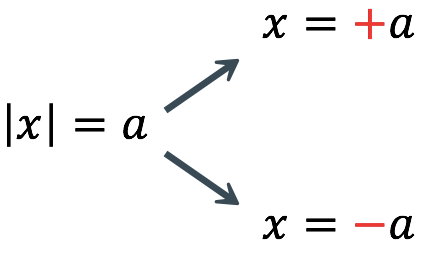
In addition, we also need to keep in mind the following key points regarding the setup above:
Key Points to Remember when Solving Absolute Value Equations
Key Point #1: The sign of \left| x \right| must be positive. For emphasis, \left| x \right| \to + \left| x \right|.
Key Point #2: The x inside the absolute value symbol, \left| {\,\,\,\,\,} \right|, could be any expressions.
Key Point #3: The a on the right side of the equation must be either a positive number or zero to have a solution.
Key Point #4: If the a on the right side is a negative number, then it has no solution.
Examples of How to Solve Absolute Value Equations
Example 1: Solve the absolute value equation \left| x \right| =\, - 5 .
The absolute value of any number is either positive or zero. But this equation suggests that there is a number that its absolute value is negative. Can you think of any numbers that can make the equation true? Well, there is none.
Since there's no value of x that can satisfy the equation, we say that it has no solution.
In fact, the following absolute value equations don't have solutions as well.

Example 2: Solve the absolute value equation - \left| x \right| =\, - 5 .
Don't be quick to conclude that this equation has no solution. Although the right side of the equation is negative, the absolute value expression itself must be positive. But it is not, right?
Key Point #1 : The sign of \left| x \right| must be positive. For emphasis, \left| x \right| \to + \left| x \right|.
What we need is to eliminate first the negative sign of the absolute value symbol before we can proceed.
Observe that the given equation has a coefficient of −1. Divide both sides of the equation by this value to get rid of the negative sign.

Since the absolute value expression and the number are both positive, we can now apply the procedure to break it down into two equations.

Therefore, the solution to the problem becomes

You may verify our answers by substituting them back to the original equation. I'll leave it to you.
Example 3: Solve the absolute value equation \left| {x - 5} \right| = 3 .
This problem is getting interesting since the expression inside the absolute value symbol is no longer just a single variable. Don't worry; the set-up remains the same. Just be careful when you break up the given absolute value equation into two simpler linear equations, then proceed how you usually solve equations.
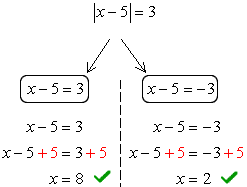
You may check the answers back to the original equation.
Example 4: Solve the absolute value equation \left| { - 2x + 7} \right| = 25 .
You may think that this problem is complex because of the –2 next to the variable x. However, that shouldn't intimidate you because the key idea remains the same. We have the absolute value symbol isolated on one side and a positive number on the other. Solving this is just like another day in the park!
Break it up into the + and - components, then solve each equation.

Example 5: Solve the absolute value equation \left| { - 6x + 3} \right| - 7 = 20.
This one isnot ready just yet to be separated into two components. Why? It is because the absolute value symbol is not by itself on one side of the equation. If you look at it, there is a-7 on the left side that must be eliminated first. Once we get rid of that, then we should be okay to proceed as usual.
Eliminate the -7 on the left side by adding both sides by \color{blue}7.

Now, we have an absolute value equation that can be broken down into two pieces.
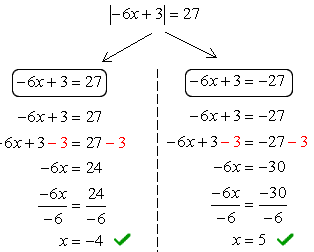
Example 6: Solve the absolute value equation - 7\left| {9\, - 2x} \right| + 9 =\, - 12.
The absolute value expression is not isolated yet. Eliminate the +9 first and then the -7 which is currently multiplying the absolute value expression.
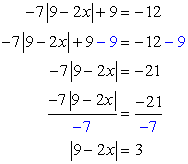
Now, let's split them into two cases, and solve each equation.
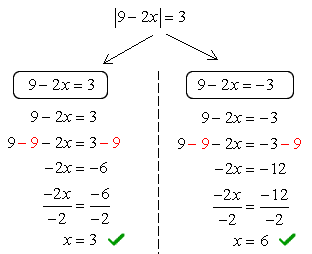
Example 7: Solve the absolute value equation \left| {{x^2} + 2x - 4} \right| = 4.
This is an interesting problem because we have a quadratic expression inside the absolute value symbol. I hope you don't get distracted by how it looks! If you're faced with a situation that you're not sure how to proceed, stick to the basics and things that you already know.
We don't care about the "stuff" inside the absolute value symbol. As long as it is isolated, and the other side is a positive number, we can definitely apply the rule to split the equation into two cases.
In fact, the only difference of this problem from what you've been doing so far is that you will be solving quadratic equations instead of linear equations.
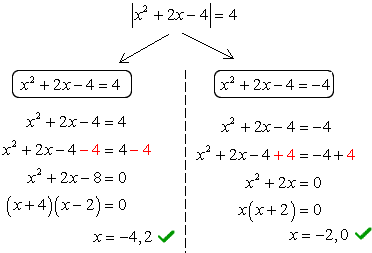
We can verify that our four answers or solutions are x = - \,4, -2, 0, and 2, by graphing the two functions and looking at their points of intersections.
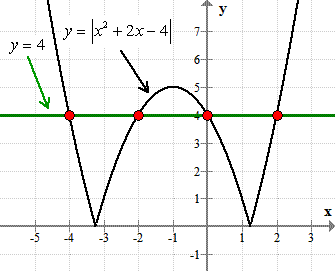
Solving Absolute Value Equations Worksheets
You might also be interested in:
Graphing Absolute Value Functions
Solving Absolute Value Inequalities
How To Get Rid Of Absolute Value
Source: https://www.chilimath.com/lessons/intermediate-algebra/solving-absolute-value-equations/
Posted by: ortegawhatife1996.blogspot.com

0 Response to "How To Get Rid Of Absolute Value"
Post a Comment